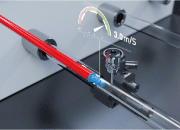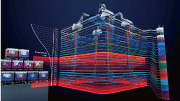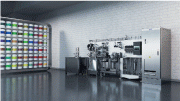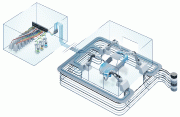E-Archive
Articles
in Vol. 25 - March Issue - Year 2024
A Variety of Colors in Small Quantities

Picture 1: Fast pig, fast color change. The pig pushes the leftover paint back into the container at 3 m/s, leaving no residue.

Picture 2: Just ten colors comprise 90% of production. A special paint supply system is better suited than a ring-pipe system for the remaining rarely used colors.

Picture 3: Paint mixing room

Picture 4: The ideal combination for sustainability and economy: Ring-pipe systems supply the most popular colors and special color supply systems supply less popular ones
Special paint supply systems make a virtually unlimited number of paint colors available quickly, economically, and without residue. Paint supply systems for special colors with low production rates are more economical and sustainable for industrial automotive painting than conventional ring-pipe systems. These systems significantly minimize paint loss, waste, and rinsing agent consumption.
Offering a vehicle in only one color, such as the legendary Ford Model T exclusively in black, is unimaginable today. The global demand for passenger cars in many colors is growing, forcing manufacturers to offer a range of color options. This demand is fueled by ever-shorter model cycles, where new color palettes always accompany model updates and consumer desire to personalize cars with special colors. In the commercial vehicle segment, it has long been commonplace for almost every vehicle color to match the future owner’s corporate identity (CI). Commercial vehicle paint shops require up to 1,000 different colors for this purpose. Special paint supply systems facilitate this extensive color range, and their application in the passenger car sector also offers enormous savings potential. This approach is both more sustainable and more cost-effective in accommodating an increasing variety of colors than conventional ring-pipe systems.
High overhead for small-batch colors
A look at the production rates of paint shop colors highlights the potential for cost and resource savings with special paint supply systems. Analyses conducted by various car manufacturers indicate that more than 90 percent of the total production volume comprises no more than ten colors, meaning that the remaining colors – many used only once a day or even less frequently—make up a negligible percentage of the total production volume.
Traditionally, most paint shops employed several conventional ring-pipe systems to apply small-batch colors with low production rates. This approach makes no economic or ecological sense since the liquid paints require constant motion to prevent color the pigments from settling. Mechanical forces cause shearing during circulation, negatively impacting the properties of complex paints. Rarely used colors, which receive minimal fresh material, quickly reach critical levels, nega-tively affecting paint quality. Fresh paint must be added at regular intervals to ensure the quality of these rarely used colors. However, since only a small quan-tity of paint is used at one time, appropriate quantities must be disposed of to maintain the paint quality.
Ring-pipe systems only for the most popular colors
On the other hand, special paint supply systems store the required paint colors in climate-controlled paint mixing rooms, and will not provide them to the painting robot until right before a car body enters the paint booth. Since shearing does not negatively impact paint quality, paint loss – and hazardous waste – is minimized. Supplying paint via ring-pipe systems, therefore, only makes sense for the most popular colors, like white, black, silver, and gray, as well as a few other colors with production rates higher than five percent. A maximum of ten ring-pipe systems are needed for this. For all other colors, a special paint supply system is not only more cost-effective to operate, but also more sustainable.
Special paint supply systems have a quick return on investment
Given the sharp increase in paint prices, particularly for special paints, piggable systems for supplying special paint colors pay for themselves rapidly through the almost complete recovery of the unused paint. The average return on investment for a Dürr EcoSupply P paint supply system, with 600 units currently installed worldwide, is about 18 months on average. A single system can provide unlimited colors consecutively for application, offering unparalleled flexibility. Specially designed components, known as ”pigs”, precisely match the internal diameter of the hoses – pushing the paint to the color changer and, after painting, pushing the leftover paint back into the paint container. Since the entire process leaves no residue, cleaning is unnecessary, reducing both paint and rinsing agent consumption – beneficial for budgets and the environment.
Modular special paint supply systems, suitable for applying both water and solvent-based paints, are available in different versions. The easy-to-use single-pass system is the most popular. It guarantees almost 100 percent paint recovery, significantly reducing the amount of valuable paint used. The single-pass method connects each painting robot to its own source and destination module via a pigging hose, enabling the exact definition of the individual paint quantity allocated to each robot for a specific body type. Including a small reserve quantity permits quick adjustments to the spray pattern (brush changes) and ensures that the pigs can glide through the paint recovery process. Once the application is complete, compressed air transports any unused paint back into the container. In Dürr systems, the pigging technology’s destination stations integrate seamlessly with the EcoMCC3 or EcoLCC color changers on the painting robot, minimizing paint loss during the transition from the paint supply system to the application technology. Additionally, third-party robots can also be connected.
Color changes in just 15 minutes
The efficiency of special color supply system is also the result of fast color changes. While it takes days to switch a ring-pipe system to a new color, the special paint supply system achieves this in about 20 minutes, depending on the length of the robot line and the number of robots installed. DXQ3D.onsite software performs automatic paint quantity calculations, optimizing the loading process and contributing to the rapid color change. Another Dürr innovation expedites the process even more: An additional injection valve sprays a small quantity of solvent into the pipe before the paint is recovered and enables the pigs to travel back at a speed of up to 3 m/s, compared to the previous 1 m/s. This shortens the color change time to approximately 15 minutes, ideal for the state-of-the-art n-in-4 system capable of consecutively painting several vehicles in a different special color. To meet the requirement for automatic paint recovery, the paint station connects a large number of containers ranging in size from 25 to 1,000 liters to up to four pigging systems. A special paint supply system can achieve continuous painting when combined with larger containers. The system is designed as a main pass for this, with one piggable hose per booth side supplying the extraction points.
Thanks to their modularity, the systems are flexible and suitable not only for newly built plants but also for existing systems. For example, when updating an existing line during a model change, it makes sense to replace the existing ring-pipe systems – especially for colors with low production rates – with a special paint supply system. The system’s benefits include minimal paint loss, low rinsing agent consumption, extremely short color change time, and lower environmental impact due to less waste.
For Information:
Dürr Systems AG
Carl-Benz-Str. 34
74321 Bietigheim-Bissingen, Germany
Tel. +49.7142.78-4899
E-mail: info@durr.com



























